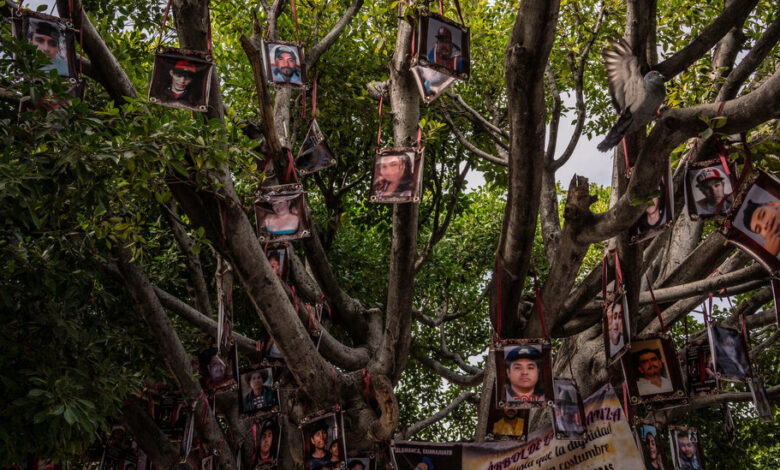She Looked for Her Missing Brother. Now, People Are Looking for Her.

Only a few torn pieces of the crime scene tape around Lorenza Cano’s house are left. The shards of glass from the front door are gone. So are the bullet casings.
All that remains is the hope that Ms. Cano will be found.
The 55-year-old activist is one of hundreds of women in Mexico who became advocates for the country’s disappeared population after their own loved ones went missing. Ms. Cano’s brother, José Francisco, was abducted in 2018 and never found.
Now, she herself has vanished.
Last week, gunmen burst into her home in Salamanca, an industrial city in Mexico’s central state of Guanajuato, killing her husband and son and taking her away into the night.
The abduction has highlighted one of Mexico’s most haunting national tragedies: a crisis of disappearances.
Impunity is rampant, public security forces have been involved in some of these crimes and clandestine gravesites have been discovered around the country.
Ms. Cano’s disappearance has dealt a devastating blow to her community in Salamanca, where cartel warfare has spurred record violence in recent years. Local searchers are now worried about their own vulnerability.
“We are left with the question: ‘Now when are they going to come for me and take me away?’” said Alma Lilia Tapia, the spokeswoman for Salamanca United in the Search for the Disappeared, a group of 206 families searching for their missing loved ones, and of which Ms. Cano is a member.
Ms. Tapia has been looking for her son, Gustavo Daryl, since he was abducted in 2018 from his food stand, apron on and grill tongs in hand.
The government says more than 94,000 people are missing in Mexico, though the United Nations says that could be an undercount. The majority of cases remain unsolved, as detailed investigations are often not completed. Family members are left on their own to comb through clues and follow up on leads in desperate efforts to find their loved ones — or, perhaps, receive some closure.
“There’s no protection,” Ms. Tapia, 55, said from her living room, a few blocks away from Ms. Cano’s house. “We’re all at risk here.” Dozens of missing person fliers crowded her dining table. Handmade embroidery on the walls paid tribute to the disappeared.
Violence in Guanajuato has surged in recent years as the Jalisco New Generation Cartel and the local Santa Rosa de Lima Cartel battle for control in the state. About 21,200 people have been killed in the past six years in Guanajuato, according to government figures, making it one of Mexico’s deadliest states.
Those left to search for the disappeared have also become targets. In Guanajuato, the U.N.’s human rights office documented the killing of at least five people searching for their missing relatives from 2020 through 2023.
“The search for missing people touches the interests of criminal groups, or possibly agents of the state, and therefore constitutes a threat,” said Raymundo Sandoval, a member of the Platform for Peace and Justice in Guanajuato, a coalition that offers support to the families of the disappeared. The attacks on searchers “have an immediate, inhibitory effect.”
It’s unclear why Ms. Cano was targeted. She wasn’t a high-profile activist and mostly did administrative work since a bad hip prevented her from going into the field.
“Unfortunately, in this case, there was no previous clue, no prior threat,” said Guillermo García Flores, Salamanca’s municipal secretary. “It was a totally surprising event.”
Last week during a news conference, President Andrés Manuel López Obrador said he had no information about the case. “But every day we are protecting the people and there is no impunity for anyone,” he added.
Volunteers searchers in Salamanca say they have little faith in local and federal officials.
“We feel wronged,” said María Elena Pérez, 62, another member of the collective whose daughter, Martha Leticia, was abducted in 2018.
“We have no support from the government, no security or anything. There are times when we have to go around looking by ourselves, however we can,” she said. “We want all this to change.”
Julio César Prieto Gallardo, Salamanca’s mayor, defended his administration’s actions. “We give support, regardless of whether they deny it,” he said in an interview, referring to families who criticize the government’s response to disappearances. “The doors of the municipality of Salamanca are open.”
This week, two men were arrested and charged with murder and disappearance in connection to Ms. Cano’s case.
Only five days before her abduction, Claudia Sheinbaum, the presidential candidate for Mexico’s governing Morena party held a rally in Salamanca and acknowledged the violence sweeping the region.
“Guanajuato was a prosperous, safe state. And today it ranks first in homicides in the whole country,” she told the crowd. “Here, instead of making the economy grow, investments are fleeing because of insecurity.”
Before the speech, Ms. Tapia, the Salamanca collective spokeswoman, climbed over a railing to hand Ms. Sheinbaum an envelope with a list of demands that called on whomever is elected as president later this year not to abandon the organization and their mission.
Ms. Sheinbaum promised she wouldn’t, Ms. Tapia said. But those were words that the collective has heard before. “It has happened to us that they take on the issue and then they forget about us,” she said.
Mr. López Obrador’s administration has been criticized for a recount of the official registry of disappeared people presented in December — an effort, the government said, to update the database and eliminate false entries. The new census decreased the number of disappeared from nearly 111,000 to about 94,000 in the national registry, but critics argued that the process was opaque.
At the end of the recount, officials said only about 12,370 people could be “confirmed” as missing, though they acknowledged that more than 62,000 cases lacked even basic information for beginning a search.
Some of the collective’s members recently met outside a bar in downtown Salamanca. They were searching for human remains that they were told had been buried near a river.
“Our time is running out. We are getting older,” said Ms. Tapia. Fragments of bones, which she identified as belonging to animals, dotted the field.
Still, not age, health issues or pressure from family members would keep them from doing their job, said Francisca Caudillo, another searcher.
Ms. Caudillo, 50, is one of the few who have found a missing loved one. Last July, she was on site when the collective unearthed the body of her son, Martín Eduardo, from a landfill. She had been looking for him for more than two years. When his remains were finally returned home, Ms. Caudillo had flowers, live music and fireworks to commemorate him.
“I like it when I find someone, whoever it is,” she said. “It gives me a little bit of peace to know they’re reunited with their family.”
Simon Romero contributed reporting from Mexico City, and Miguel García Lemus from Salamanca, Mexico.




